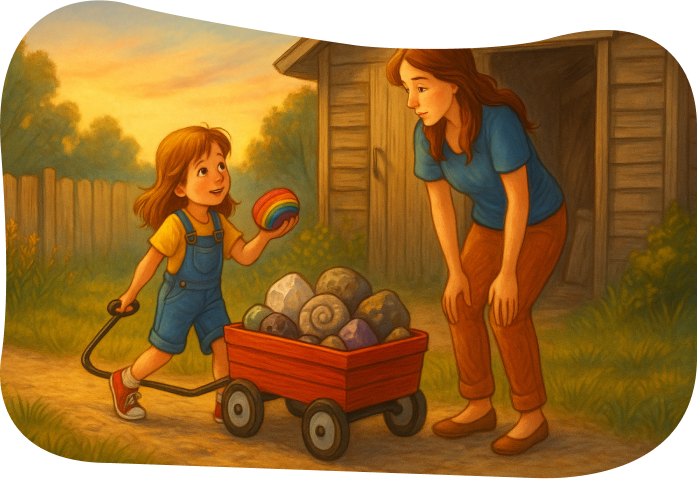
What makes a simple story stay in our hearts long after the last page is turned? Why does a tale about a child pulling a wagon, or a rabbit searching for a home, feel like more than just a bedtime read? The answer often lies in symbolism—the quiet, powerful language of meaning that transforms children’s stories into timeless life lessons. In Karen R. Sullivan’s The Blue Wagon, symbolism is not just decoration; it is the heartbeat of the story. Through a six-year-old girl’s treasure hunt, Sullivan conveys a gentle yet significant reminder of how burdens, kindness, and promises shape both childhood and adulthood. Heather, the young heroine of The Blue Wagon, sets out with her empty wagon to collect treasures. To her, each stone she finds—whether sparkling crystal, painted rainbow rock, or fossil-filled treasure—is a prized discovery. But as the wagon grows heavy, Heather grows weary. The literal weight of the rocks becomes a symbol for the emotional and spiritual burdens we all carry.
This is where the story reaches beyond the pages of a children’s book. To a child, the message is clear: sometimes we get tired because of the loads we carry. But to an adult reader, the meaning deepens. Sullivan shows us that life’s worries—our own rocks—drag behind us, often overlooked until the weight slows us down. The wagon becomes a metaphor for the soul, holding both treasures and troubles, and reminding us that even childhood lessons show life’s universal truths. No good children’s story is complete without a mentor figure, and in The Blue Wagon that role belongs to Mr. Wiggledimp, Heather’s elderly neighbor. With his whimsical name and gentle spirit, he is more than just a character—he symbolizes kindness, memory, and the importance of intergenerational wisdom. When he gives Heather his cherished painted rock, he is not simply offering her a gift; he is passing down a piece of himself, a legacy of value that others might overlook. To Heather, the rock is beautiful. To Mr. Wiggledimp, it represents years of life and meaning. In sharing it, he teaches Heather that treasures are not measured by material worth but by the heart behind them. Symbolically, he reminds us that children thrive when adults notice them, share with them, and take their experiences seriously.
Beyond the rocks, the wagon itself is one of the book’s most striking symbols. At first, it is light, empty, and full of possibility—just as childhood begins. As Heather adds to it, the wagon becomes heavy, just as life’s responsibilities and experiences accumulate. By the time she returns home, Heather has discovered a truth that her mother later puts into words: burdens, whether rocks or worries, weigh us down. In this way, the wagon is more than a toy—it becomes a symbol of growth, responsibility, and the passage from innocence into awareness. Sullivan subtly guides readers, both young and old, to see that everyone carries a wagon, whether visible or invisible. The key is learning how to recognize its weight and to share it with those who care. Heather’s mother is tired, preoccupied with dinner, and at first unable to look at her daughter’s treasures. Yet she eventually keeps her word and goes with Heather to see the rocks in the shed. That act becomes symbolic of something greater: the promise of listening to children. In children’s literature, parents often stand as symbols of reliability or absence, shaping the child’s understanding of trust. Here, Heather’s mother symbolizes the power of presence. By keeping her promise, she validates Heather’s day and her effort. By comparing the rocks to worry, she also bridges the symbolic lesson, showing Heather that burdens exist at every stage of life.
Through this moment, Sullivan emphasizes the importance of noticing children—not dismissing them, not pushing them aside, but recognizing the treasures they bring. The symbolism here is clear: listening is love, and keeping promises builds the foundation of trust between generations. Children may not yet have the vocabulary to describe life’s biggest truths, but they feel them. Symbolism gives children a way to see these truths in a form they can grasp. Rocks become worries. Wagons become burdens. A kind neighbor becomes the embodiment of compassion. For adults, the same symbols open doors to reflection. They remind us of the inner child we once were and invite us to revisit the lessons we may have forgotten. Sullivan herself hints at this in her project notes: The Blue Wagon is not only for children but also for the “adult inner child.” By speaking through symbols, the story touches across generations. Though God is not directly mentioned in The Blue Wagon, Sullivan gently crafts spiritual undertones through her use of symbols. The wisdom of Mr. Wiggledimp, the lesson of worry, and the promise of keeping one’s word echo themes of faith, kindness, and trust. Readers are reminded of verses like “Let not your heart be troubled” (John 14:1) and the simple wisdom of teachers like Mr. Rogers, who emphasized kindness and listening. The symbols transform the story from a child’s treasure hunt into a lesson that makes us think.
Quick Links
Useful Links
Copyright © 2025 Karen Sullivan. All Rights Reserved.